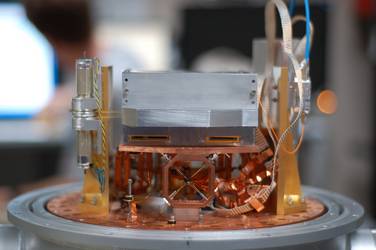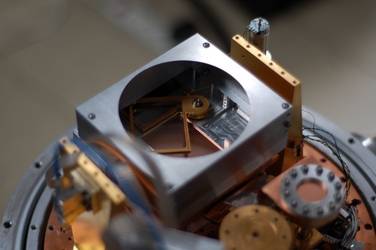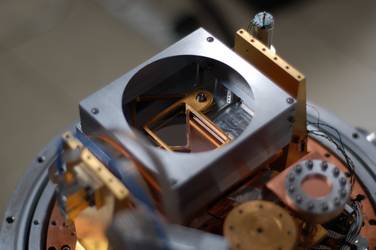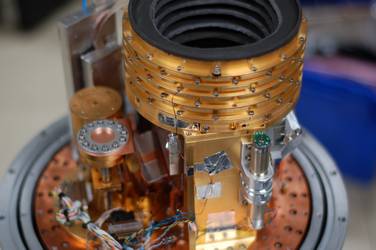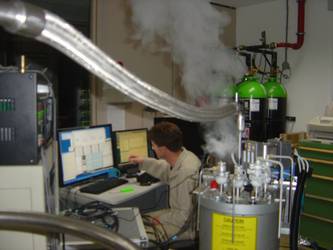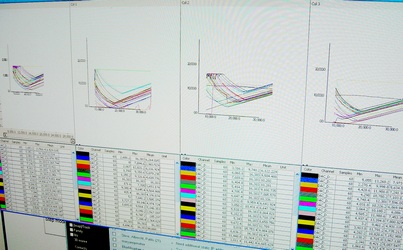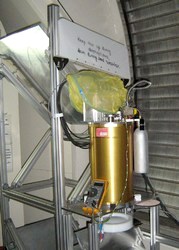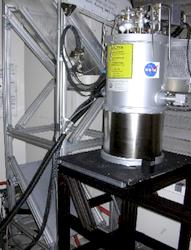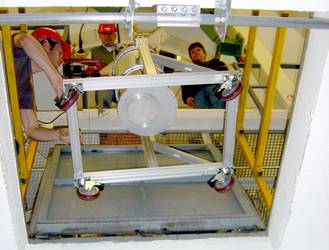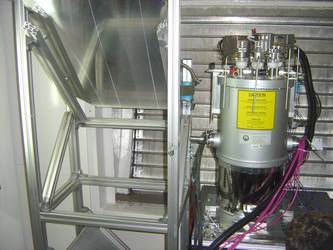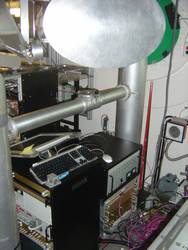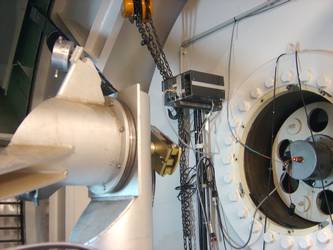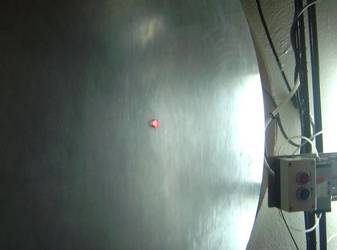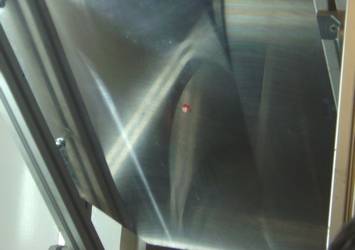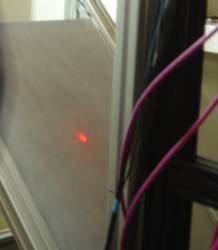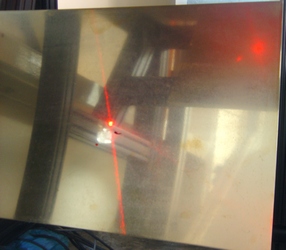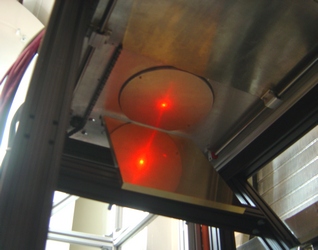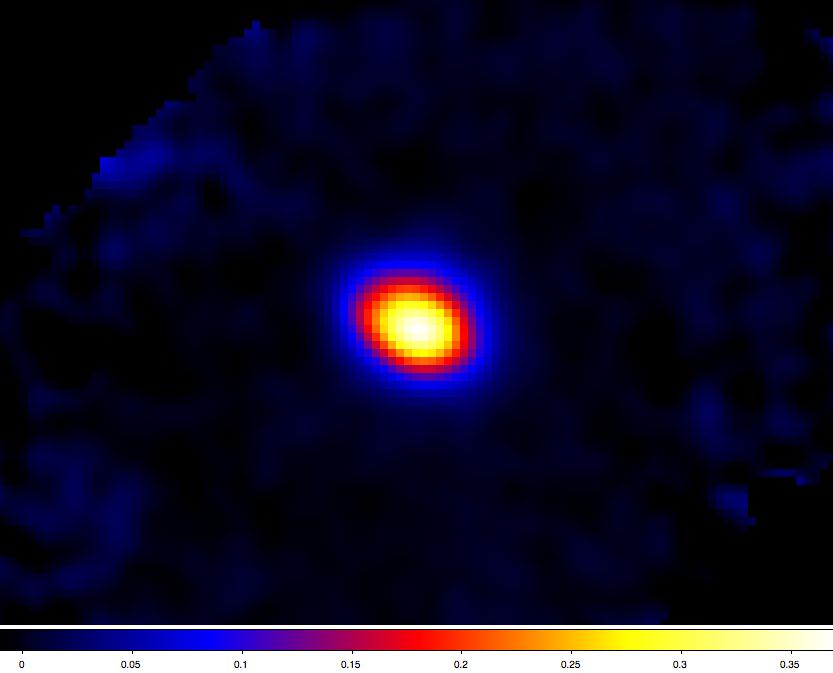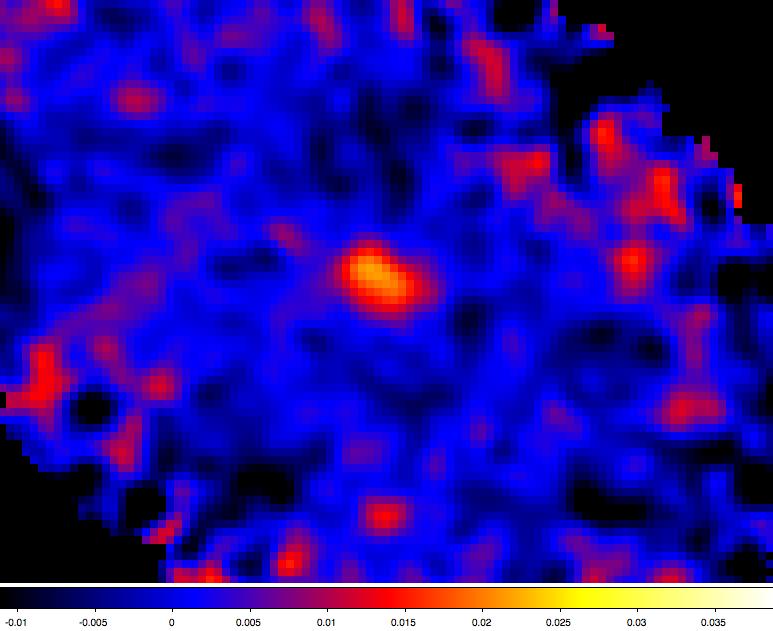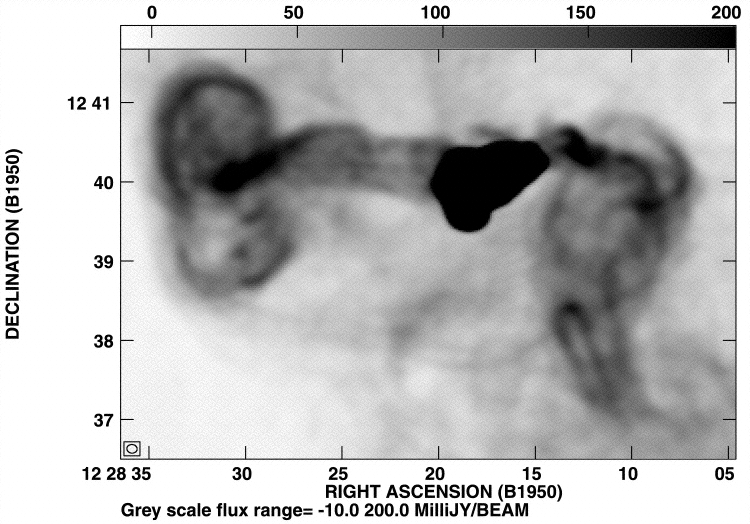|
Size: 857
Comment:
|
Size: 11075
Comment:
|
| Deletions are marked like this. | Additions are marked like this. |
| Line 1: | Line 1: |
| '''GISMO - The Goddard-IRAM Superconducting 2 Millimeter Observer''' | = GISMO - The Goddard-IRAM Superconducting 2 Millimeter Observer = |
| Line 3: | Line 3: |
| This 8x16 BUG 2mm bolometer camera has been tested at the 30m telescope in November 2007 and in October 2008. The bandwidth is 125-175GHz, the HPBW is about 17", pixels are offset by 14". PI is [http://www.astro.umd.edu/people/staguhn.html Johannes Staguhn] [http://gsfctechnology.gsfc.nasa.gov/Detector.htm (Goddard)], [http://www.phys.ufl.edu/tes3/pdfs/Benford_TES_Bolometer_Arrays_Poster.pdf Poster on TES Bolometers] | This page is maintained by CK, SL, and the GISMO team |
| Line 5: | Line 5: |
| attachment:gismo-team.png | <<Anchor(beginOfPage)>> <<TableOfContents(5)>> == 3rd GISMO test run, April 2010 == === Staffing of the test run === * GSFC: J. Staguhn, D. Fixsen, A. Kovacs, S. Maher, E. Sharp, D. Benford * IRAM: S. Leclercq, A. Sievers, G. Quintana-Lacaci, R. Zylka === Test run schedule: 31.03. - 16.04.2010 === '''IRAM 30m schedule page: ''' [[http://www.iram.fr/IRAMFR/PV/sche/sche.html|Schedule]] '''T16-09''' in 30m schedule = GISMO has telescope time Participants presence dates: [[attachment:Schedule_GISMO_visitors_April2010.pdf]] || '''#''' || '''Dates''' || '''Main Task''' || '''Details''' || '''Lead (GSFC/IRAM)''' || '''Support''' || || || 31.03. Wednesday || || Arrival of ES, first GISMO visitor, in Granada || || || || || 01.04.-05.04. || Mount upgrades, close and cool down in the 30m workshop || Arrival of SM || || || || || 06.04. Tuesday || Turn on GISMO, and 1st tests in the 30m workshop || Arrival of JS, DF, AK, SL, AS. || Johannes / Samuel || Albrecht (AoD) || || || 07.04.-08.04. || Tests in the 30m workshop || Bias, Tuning, IV curves, internal LED, Computer... || Johannes / Samuel || Albrecht (AoD) || || || 09.04. Friday || Installation in the cabin, cool down, alignment, background noise || Arrival of RZ || Johannes / Samuel || Albrecht & Guillermo (AoD) || || || 10.04.-12.04. || Calibration on sky (alignment, pointing, focus, dips), observations '''T16-09''' || 12.04.: Arrival of DB, departure of AS, SL, RZ || Johannes / Samuel || Guillermo (AoD) || || || 13.04.-15.04 || Observations '''T16-09'''|| || Johannes || Guillermo (AoD) || || || 16.04. Friday || Dismounting || Departure of everybody || Johannes || Guillermo (AoD) || Compilation of the lists of sources that will possibly be observed (include few references to past runs): [[attachment:GISMOtestrun3_sources.pdf]]. Comments from Johannes about the proposed science grade sources: [[attachment:IRAM_Proposed_Sources_Comments.pdf]] === GISMO upgrades compared to previous runs === * 2 motorized neutral density filters allowing to compensate the restrained dynamic range of GISMO by reducing the optical transmission in case of poor weather conditions, their transmissions are 65% and 40% respectively. * A controllable shutter and a LED coupled to detectors through a fiber allowing to make optical internal calibration * Automated observing procedures usable via a dedicated GUI such as detector tunning, sky dips, I-V measurements for total power measurements * A reduction package (Crush) allowing near-to-real-time data processing * An observer's manual of the GISMO operating software: [[attachment:GISMO_Software_Operational_Manual.pdf]] === Daily reports === ==== 31.03. - 05.04. ==== Arrival of Elmer & Stephen. Mount GISMO in the 30m workshop. The pictures below show several elements of the optical stage of GISMO: the 4K motors controlling the neutral density filters, the neutral density filters in motion, the baffle with the NDF motors and the 3He sorption cooler, and a general view of GISMO mounted. ||{{attachment:GISMO_4K_NDfilters_motors.jpg}} {{attachment:GISMO_NDfilter_1_moves.jpg}} {{attachment:GISMO_NDfilter_2_moves.jpg}} {{attachment:GISMO_baffle_3He_cooler.jpg}} {{attachment:GISMO_recycle_in_workshop.jpg}} {{attachment:GISMO_IV_curves.jpg}}|| Start cooling down on Monday the 05.04. ==== 06.04. - 08.04. ==== Arrival of Johannes, Dale, Attila, and Samuel. GISMO is cold. Turn on the instrument, BIAS the SQUIDs, monitor the TESs responses, take IV curves: all 4 quadrants are working, about ~20 non-responsive pixels (mostly due to SQUID issues in the MUX). LED illumination not visible in the real time data, but appears finely in reduced curves. Problems of strange wiggles in the IV curves. Install the GISMO frame in the cabin, but keep everything else (GISMO & electronics) in the workshop. Find next morning that the problem with the IV curves was surely due to CPU overheating. A new power supply (with large fan) was installed and an external heat source (another computer) was removed. Subsequently things looks fine, frequency plots show 1/f^2 noise certainly due to thermal oscillations. We noted that the bars holding M5 are below it and wondered whether this position would block partially the FOV and whether they weren't above M5 in the past, in particular for previous runs. As the pictures show below they were already below M5 when MAMBO was reinstalled in December 2007 after the 1st GISMO run, and they were also in this position during the 2nd GISMO run in 2008: ||{{attachment:MAMBO_30m_table_12_2007.jpg}} {{attachment:GISMO_30m_table_10_2008.jpg}}|| So the bars supporting M5 have probably always been in that position and are not an issue concerning the FOV. ==== 09.04. Friday ==== Start moving GISMO in the 30m receiver cabin in the morning. Perform the laser alignment. ||{{attachment:GISMO_moving_in_Rx_cabin_2.jpg}} {{attachment:GISMO_installed_in_Rx_cabin.jpg}} {{attachment:GISMO_installed_in_Rx_cabin2.jpg}} {{attachment:GISMO_installed_in_Rx_cabin3.jpg}} {{attachment:Laser_alignment_1.jpg}} {{attachment:Laser_alignment_2.jpg}} {{attachment:Laser_alignment_3.jpg}} {{attachment:Laser_alignment_4.jpg}} {{attachment:Laser_alignment_5.jpg}} {{attachment:Laser_alignment_6.jpg}}|| A temperature jump occurred during the installation. The detectors reached their base temperature near diner time. IV curves with the cryostat shutter closed showed more than 100 bolometers respond with nice superconducting transitions. But once the shutter was open all the TESs saturated and couldn't reach the superconducting transition: impossible to align on the sky. Telescope shutter was closed... Redo all the alignment procedure. But saturation problem still there. Numerous procedures tried to diagnose the problem an fix it. The only way to get and optical alignment on the sky was to install a metallic disc with a small aperture (few cm in diameter) in front of the cryostat window. The most probable explanation is a broken filter in the cryostat. Once all the hypothesis and tests we could imagine were conducted the decision is taken near 5am to warm up the cryostat. ==== 10.04. - 11.04. ==== The 30m is used by a backup project. The cryostat reached room temperature in the evening, and was dismantled. No problem seen on the filters. Main hypothesis explaining the saturation at cold temperature when the window is open to the sky: some stray-lights can bounce at angles steep enough to be badly attenuated by the filters, but not too much so that they pass the baffle without touching its wall, then they bounce with many reflections in the Neutral Density filters box and are eventually absorbed by the TESs, deposing enough energy to saturate them. Hence it was decided to remove the ND box and replace it by the cylindrical spacer used in GISMO run #2. GISMO was remounted then pumped during the night, and the cool down started early Sunday morning. Base temperature expected Sunday after diner. ||{{attachment:Open_GISMO_77K_stage.JPG}} {{attachment:Open_GISMO_4K_stage.JPG}} {{attachment:Open_GISMO_baffle.JPG}} {{attachment:Open_GISMO_Si_lens.JPG}} {{attachment:Open_GISMO_ND_filters_box.JPG}} {{attachment:Open_GISMO_run2_spacer_no_ND_box.JPG}}|| ==== 12.04. ==== CK: * '''Pointing session on a bunch of sources distributed all over the sky... ''' * '''Skydips... ''' * '''Any beam maps ? ''' ==== 13.04. ==== Elmer has left and Dominic has arrived. The observing started late after a careful but ultimately unsatisfying alignment. Venus appeared nicely and could be focused well. Unfortunately, the point source coupling was not any better. Careful focusing and re-alignment on Mars resulted in a very good cold sky, but again no better point source coupling. '''What was the coupling and what did you expect? (CK)''' However, the weather was decent and we decided to conduct a few science observations that would produce good results. M82 appeared as a bright, Jy-level resolved source. IC342 was weakly detected at about 20mJy, and is slightly extended. M87 is clearly detected in its core (S/N of around 500), but none of the filamentary structure seen in the 90cm maps was evident at the ~1% level. ||{{attachment:GISMO_M82.jpg|width=200}} {{attachment:GISMO_IC342.jpg|width=200pc}}|| ||{{attachment:GISMO_M87.jpg}} {{attachment:VLA_M87.gif}}|| ---- == 2nd GISMO Test run, October 2008 == In October 2008, the GISMO team Johannes Staguhn, Stephen Maher, Elmer Sharp, Dale Fixsen, and Dominic Benford spent two weeks at the 30m observatory to first install their GISMO bolometer in the lab and then in the receiver cabin to test its performance on the sky. GISMO consists of 8x16 pixels with transition edge sensors (TES). The super conducting TES are read out by SQUID multiplexers. The nominal bandwidth is 125-175GHz, pixels are spaced by 14", the telescope HPBW is 17" at 2mm. Data are taken while the telescope is performing Lissajous scan patterns, without switching the secondary, to increase the mapping efficiency. An automated pipeline merges the GISMO data with the telescope data streams to create FITS files, being triggered by the IRAM messaging system. Data are then further reduced using the Goddard data reduction package. The 2mm spectral range provides a unique terrestrial window enabling ground-based observations of the earliest active dusty galaxies in the universe and thereby allowing a better constraint on the star formation rate in these objects. Preliminary results from this second observing run at the 30m telescope look very promising. (CK, 28-Oct-2008) {{attachment:gismo-team.png}} <<BR>> |
| Line 7: | Line 115: |
| Elmer Sharp, Stephen Maher, Johannes Staguhn, Dale Fixsen, Dominic Benford (Photo by A.Sievers on October, 27, 2008) | Stephen Maher, Elmer Sharp, Johannes Staguhn, Dale Fixsen, Dominic Benford (Photo by A.Sievers on October, 27, 2008) |
| Line 9: | Line 117: |
| * [[attachment:Report_on_GISMO_Run2_Rev3.pdf]] * [[attachment:Atmospheric_Emission_Noise_at_Pico_Veleta.pdf]] * [[attachment:GISMO_run2_reply_to_J_Staguhn.pdf]] * [[attachment:GISMO_sensitivity_reply_to_D_Benford.pdf]] * [[attachment:Some_GISMO_reduced_images.pdf]] * [[http://www.submm.caltech.edu/~sharc/crush/index.htm|Crush]] |
|
| Line 10: | Line 124: |
| * attachment:SPIE_GISMO_Staguhn.pdf * attachment:Staguhn_GISMO_SPIE_08_Rev1.pdf |
---- == 1st GISMO Test run, November 2007 == * [[http://esoads.eso.org/abs/2008JLTP..151..709S|Staguhn et al. 2008]] GISMO, a 2 mm Bolometer Camera Optimized for the Study of High Redshift Galaxies * [[attachment:SPIE_GISMO_Staguhn.pdf]] * [[attachment:Staguhn_GISMO_SPIE_08_Rev1.pdf]] * [[http://www.astro.umd.edu/people/staguhn.html|Johannes Staguhn]] * [[http://gsfctechnology.gsfc.nasa.gov/Detector.htm|(Goddard)]], * [[http://www.phys.ufl.edu/tes3/pdfs/Benford_TES_Bolometer_Arrays_Poster.pdf|Poster on TES Bolometers]] |
GISMO - The Goddard-IRAM Superconducting 2 Millimeter Observer
This page is maintained by CK, SL, and the GISMO team
3rd GISMO test run, April 2010
Staffing of the test run
- GSFC: J. Staguhn, D. Fixsen, A. Kovacs, S. Maher, E. Sharp, D. Benford
- IRAM: S. Leclercq, A. Sievers, G. Quintana-Lacaci, R. Zylka
Test run schedule: 31.03. - 16.04.2010
IRAM 30m schedule page: Schedule T16-09 in 30m schedule = GISMO has telescope time
Participants presence dates: Schedule_GISMO_visitors_April2010.pdf
# |
Dates |
Main Task |
Details |
Lead (GSFC/IRAM) |
Support |
|
31.03. Wednesday |
|
Arrival of ES, first GISMO visitor, in Granada |
|
|
|
01.04.-05.04. |
Mount upgrades, close and cool down in the 30m workshop |
Arrival of SM |
|
|
|
06.04. Tuesday |
Turn on GISMO, and 1st tests in the 30m workshop |
Arrival of JS, DF, AK, SL, AS. |
Johannes / Samuel |
Albrecht (AoD) |
|
07.04.-08.04. |
Tests in the 30m workshop |
Bias, Tuning, IV curves, internal LED, Computer... |
Johannes / Samuel |
Albrecht (AoD) |
|
09.04. Friday |
Installation in the cabin, cool down, alignment, background noise |
Arrival of RZ |
Johannes / Samuel |
Albrecht & Guillermo (AoD) |
|
10.04.-12.04. |
Calibration on sky (alignment, pointing, focus, dips), observations T16-09 |
12.04.: Arrival of DB, departure of AS, SL, RZ |
Johannes / Samuel |
Guillermo (AoD) |
|
13.04.-15.04 |
Observations T16-09 |
|
Johannes |
Guillermo (AoD) |
|
16.04. Friday |
Dismounting |
Departure of everybody |
Johannes |
Guillermo (AoD) |
Compilation of the lists of sources that will possibly be observed (include few references to past runs): GISMOtestrun3_sources.pdf. Comments from Johannes about the proposed science grade sources: IRAM_Proposed_Sources_Comments.pdf
GISMO upgrades compared to previous runs
- 2 motorized neutral density filters allowing to compensate the restrained dynamic range of GISMO by reducing the optical transmission in case of poor weather conditions, their transmissions are 65% and 40% respectively.
- A controllable shutter and a LED coupled to detectors through a fiber allowing to make optical internal calibration
- Automated observing procedures usable via a dedicated GUI such as detector tunning, sky dips, I-V measurements for total power measurements
- A reduction package (Crush) allowing near-to-real-time data processing
An observer's manual of the GISMO operating software: GISMO_Software_Operational_Manual.pdf
Daily reports
31.03. - 05.04.
Arrival of Elmer & Stephen. Mount GISMO in the 30m workshop. The pictures below show several elements of the optical stage of GISMO: the 4K motors controlling the neutral density filters, the neutral density filters in motion, the baffle with the NDF motors and the 3He sorption cooler, and a general view of GISMO mounted.
Start cooling down on Monday the 05.04.
06.04. - 08.04.
Arrival of Johannes, Dale, Attila, and Samuel. GISMO is cold. Turn on the instrument, BIAS the SQUIDs, monitor the TESs responses, take IV curves: all 4 quadrants are working, about ~20 non-responsive pixels (mostly due to SQUID issues in the MUX). LED illumination not visible in the real time data, but appears finely in reduced curves. Problems of strange wiggles in the IV curves. Install the GISMO frame in the cabin, but keep everything else (GISMO & electronics) in the workshop.
Find next morning that the problem with the IV curves was surely due to CPU overheating. A new power supply (with large fan) was installed and an external heat source (another computer) was removed. Subsequently things looks fine, frequency plots show 1/f^2 noise certainly due to thermal oscillations.
We noted that the bars holding M5 are below it and wondered whether this position would block partially the FOV and whether they weren't above M5 in the past, in particular for previous runs. As the pictures show below they were already below M5 when MAMBO was reinstalled in December 2007 after the 1st GISMO run, and they were also in this position during the 2nd GISMO run in 2008:
|
So the bars supporting M5 have probably always been in that position and are not an issue concerning the FOV.
09.04. Friday
Start moving GISMO in the 30m receiver cabin in the morning. Perform the laser alignment.
|
A temperature jump occurred during the installation. The detectors reached their base temperature near diner time. IV curves with the cryostat shutter closed showed more than 100 bolometers respond with nice superconducting transitions. But once the shutter was open all the TESs saturated and couldn't reach the superconducting transition: impossible to align on the sky. Telescope shutter was closed... Redo all the alignment procedure. But saturation problem still there.
Numerous procedures tried to diagnose the problem an fix it. The only way to get and optical alignment on the sky was to install a metallic disc with a small aperture (few cm in diameter) in front of the cryostat window. The most probable explanation is a broken filter in the cryostat. Once all the hypothesis and tests we could imagine were conducted the decision is taken near 5am to warm up the cryostat.
10.04. - 11.04.
The 30m is used by a backup project. The cryostat reached room temperature in the evening, and was dismantled. No problem seen on the filters. Main hypothesis explaining the saturation at cold temperature when the window is open to the sky: some stray-lights can bounce at angles steep enough to be badly attenuated by the filters, but not too much so that they pass the baffle without touching its wall, then they bounce with many reflections in the Neutral Density filters box and are eventually absorbed by the TESs, deposing enough energy to saturate them. Hence it was decided to remove the ND box and replace it by the cylindrical spacer used in GISMO run #2. GISMO was remounted then pumped during the night, and the cool down started early Sunday morning. Base temperature expected Sunday after diner.
|
12.04.
CK:
Pointing session on a bunch of sources distributed all over the sky...
Skydips...
Any beam maps ?
13.04.
Elmer has left and Dominic has arrived. The observing started late after a careful but ultimately unsatisfying alignment. Venus appeared nicely and could be focused well. Unfortunately, the point source coupling was not any better. Careful focusing and re-alignment on Mars resulted in a very good cold sky, but again no better point source coupling. What was the coupling and what did you expect? (CK)
However, the weather was decent and we decided to conduct a few science observations that would produce good results.
M82 appeared as a bright, Jy-level resolved source. IC342 was weakly detected at about 20mJy, and is slightly extended. M87 is clearly detected in its core (S/N of around 500), but none of the filamentary structure seen in the 90cm maps was evident at the ~1% level.
|
|
2nd GISMO Test run, October 2008
In October 2008, the GISMO team Johannes Staguhn, Stephen Maher, Elmer Sharp, Dale Fixsen, and Dominic Benford spent two weeks at the 30m observatory to first install their GISMO bolometer in the lab and then in the receiver cabin to test its performance on the sky. GISMO consists of 8x16 pixels with transition edge sensors (TES). The super conducting TES are read out by SQUID multiplexers. The nominal bandwidth is 125-175GHz, pixels are spaced by 14", the telescope HPBW is 17" at 2mm. Data are taken while the telescope is performing Lissajous scan patterns, without switching the secondary, to increase the mapping efficiency. An automated pipeline merges the GISMO data with the telescope data streams to create FITS files, being triggered by the IRAM messaging system. Data are then further reduced using the Goddard data reduction package.
The 2mm spectral range provides a unique terrestrial window enabling ground-based observations of the earliest active dusty galaxies in the universe and thereby allowing a better constraint on the star formation rate in these objects. Preliminary results from this second observing run at the 30m telescope look very promising.
(CK, 28-Oct-2008)
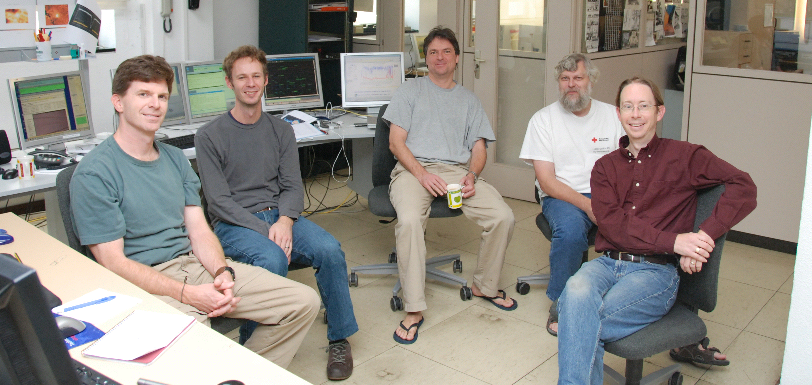
The GISMO team in the control room at the 30m telescope, after one week of 24 hours observing time. From left to right: Stephen Maher, Elmer Sharp, Johannes Staguhn, Dale Fixsen, Dominic Benford (Photo by A.Sievers on October, 27, 2008)
1st GISMO Test run, November 2007
Staguhn et al. 2008 GISMO, a 2 mm Bolometer Camera Optimized for the Study of High Redshift Galaxies

